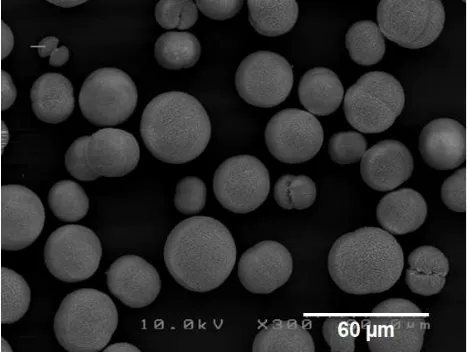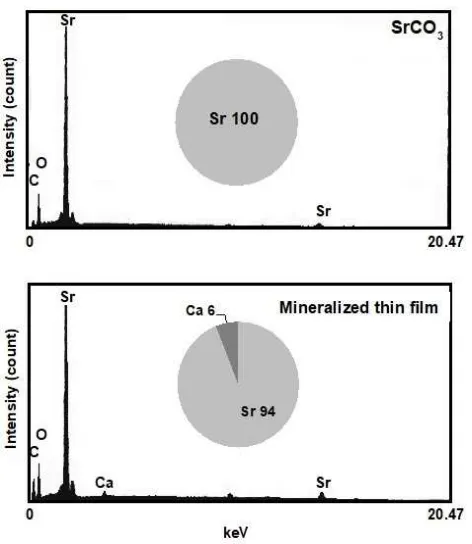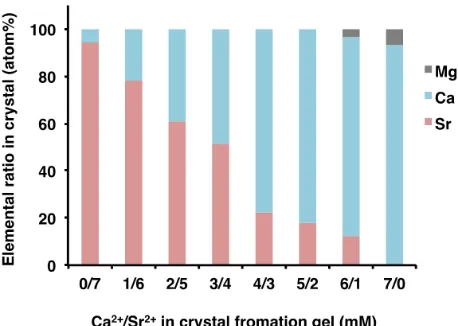of Biological Research
European Journal of Biological Research 2018; 8 (1): 1-6
Petrified
Geobacillus thermoglucosidasius
colony
to strontianite
Naoto Yoshida*, Rie Murai, Keiji Kiyoshi
Department of Biochemistry and Applied Biosciences, University of Miyazaki, 1-1 Gakuen Kibanadai-Nishi, Miyazaki 889-2192, Japan
*Corresponding author: Naoto Yoshida; E-mail: a04109u@cc.miyazaki-u.ac.jp
ABSTRACT
When biomass of the thermophilic bacteria Geobacillus thermoglucosidasius is brought into contact with a hydrogel containing sodium acetate and strontium, the biomass petrifies and hardens, becoming a mineralized thin film after incubation at 60˚C for 72 h. Analysis by energy dispersive X-ray and X-ray diffraction shows that the mineralized
thin film is strontianite. This is the first report of biomass completely changing to strontianite.
Strontianite of thermophilic bacterial origin may be formed in the hydrothermal oligotrophic
environment of the deep subsurface.
Keywords: Geobacillus; Thermophilic bacterium;
Biomineralization; Strontianite; Mineralized thin film.
1. INTRODUCTION
Strontianite was first discovered in 1787, in the heavy, white stone produced by the town of Strontian in Argyll, Scotland, United Kingdom [1]. Sir Humphry Davy subsequently discovered the element strontium in this mineral in 1808 [2]. Strontianite is actually a rare carbonate mineral, and along with celestine, it is one of the few minerals containing strontium.
To date, we have made various contributions toward clarification of the mechanisms of bacterial calcite formation and the industrial applications of calcite [3, 4]. The major contributions have been the discovery that thermophilic bacteria catalyze the formation of calcite monocrystals at 60ºC, and the discovery of a definite, reproducible method for forming calcite crystals with a matrix of hydrogels containing a lower fatty acid salt and calcium. This is a new method, whereby thermophilic bacteria biomass is brought into contact with a hydrogel, causing it to form crystals. Results to date have shown that if fresh Geobacillus thermoglucosidasius biomass is placed on agar gel containing carbo-xylates of up to 4C and calcium ions, and is incubated at 60ºC, numerous calcite monocrystals of major axis length in the region of 100 µm form within the biomass. G. thermoglucosidasius does not catalyze crystal formation if the calcium is replaced by beryllium or magnesium, which are members of the same family. In the present paper, we present a new phenomenon whereby the whole biomass of the thermophile G. thermoglucosidasius is petrified if its biomass is placed on agar gel containing strontium, a member of the same family as calcium, and we conjecture that the mineral is strontianite, which is rare in the natural world.
Received: 20 November 2017; Revised submission: 09 January 2018; Accepted: 12 January 2018
Copyright: © The Author(s) 2018. European Journal of Biological Research © T.M.Karpiński 2018. This is an open access article licensed under the terms of the Creative Commons Attribution Non-Commercial 4.0 International License, which permits
European Journal of Biological Research 2018; 8 (1): 1-6 2. MATERIALS AND METHODS
2.1. Preparation and observation of mineralized thin film
In order to obtain fresh biomass, G. thermo-glucosidasius was seeded onto soytone-casein digest (SCD) agar culture medium and cultivated for 18 h at 60ºC. Fresh G. thermoglucosidasius biomass (wet weight, 10-20 mg) was scraped off with a loop and applied to the surface of agar gel containing
7 mM strontium chloride and 25 mM sodium acetate (crystal forming gel) so that it formed a circle approx. 1 cm in diameter (Fig. 1). This was incubated for 72 h at 60ºC. Changes in the biomass applied to the crystal forming gel were observed using a SZX-ILLK100 stereoscopic microscope (Olympus Corporation, Tokyo, Japan). Mono-crystals were observed using a scanning electron microscope in accordance with the customary protocols [4].
Figure 1. Method for converting Geobacillus thermoglucosidasius biomass into mineralized thin film. The method is
simply to apply 10–20 mg of cells of G. thermoglucosidasius cultured on SCD medium to the surface of agar gel in a circle 1 cm across, and maintain them at 60ºC for 72 h. The biomass petrifies, becoming a mineralized thin film.
2.2. Energy dispersive X-ray elemental analysis of mineralized thin film
The elemental composition of the minerali-zed thin film was investigated using an energy dispersive X-ray (EDX) analysis device (EMAX-5770; Horiba, Ltd.). Analyses were carried out at an accelerating voltage (tube voltage) of 20.0 kV and a probe current of 0.26 nA. Strontium carbonate (Wako Pure Chemical Industries, Ltd.) was used as the reference spectrum.
2.3. Powder X-ray diffraction analysis of mineralized thin film
Powder X-ray diffraction analysis of mine-ralized thin film was carried out using a PW3050/65 powder X-ray diffractometer (PANalytical) fitted with a copper rotary anticathode, a graphite-monochromator, a scintillation counter, and a rotary sample stage. Analyses were carried out according to the Bragg-Brentano method, at an output voltage of 45 kV and 40 mA, with a divergence slit of 0.87º
and a receiving slit of 0.1 mm. Scanning regions of the diffraction angle (2θ) were 10º-90º at a step
interval of 0.025º, and the scanning rate was 4.0º/min. The mineralized thin film was ground into powder in a microtube and was placed on a sample stage. The reference spectrum was obtained from strontium carbonate (Wako Pure Chemical Industries, Ltd.). The waveform of the thin mineralized film spectrum was compared to the International Centre for Diffraction Data (ICDD) database for identification.
2.4. Energy dispersive X-ray elemental analysis of mineral crystals prepared on gel containing mixed calcium and strontium
for-European Journal of Biological Research 2018; 8 (1): 1-6 ming gel) so that it formed a circle approx. 1 cm in
diameter. Concentrations of calcium and strontium in the agar gel were combined as follows; with
calcium concentrations of 0, 1, 2, 3, 4, 5, 6, and 7 mM, the respective strontium concentrations were
7, 6, 5, 4, 3, 2, 1, and 0 mM. The culture was incubated for 72 h at 60ºC. The mineral that formed was prepared according to conventional protocols [3], and energy dispersive X-ray (EDX) elemental analysis was performed.
2.5. Inductively coupled plasma (ICP) atomic emission spectroscopy
Samples of 5-10 g of the mineral crystals that had formed on crystal forming gel containing strontium and calcium in different proportions was completely dissolved in 1N hydrochloric acid and made up to a final volume of 25 ml with pure water. The elemental composition of each of these solu-tions was analyzed by inductively coupled plasma atomic emission spectroscopy using an ICPS-8100 emission spectrometer (Shimadzu Corporation).
3. RESULTS AND DISCUSSION
3.1. Preparation and observation of mineralized thin film
The biomass applied to the crystal forming gel was a G. thermoglucosidasius colony, and immediately following application to the gel, it had a fresh luster (Fig. 2A). After incubation for 7 h at 60ºC, many well shaped globular monocrystals 20-50 µm in size had appeared in the biomass (Fig. 3). The number of monocrystals in the biomass increased with time, and they began to form clusters that adhered to one another. After 72 h, the biomass on top of the crystal forming gel was covered by mineral crystals, so that the biomass in its entirety was petrified with its shape intact (Fig. 2B). The petrified biomass was strong and could easily be pulled off the surface of the crystal forming gel (Fig. 2C). A magnified image shows that the petrified bacteria are a thin film formed of globu- lar monocrystals massed together (Fig. 2D). The
thickness of the thin film is 20-50 µm. All lumps of biomass appear to have been replaced by hard, inorganic mineral.
Figure 2. Petrification of Geobacillus thermoglucosi-dasius biomass on solidified agar containing 25 mM sodium acetate, and 7 mM strontium chloride. G. thermo-glucosidasius biomass was placed onto the agar surface (A). After incubation at 60˚C for 72 h, biomass transformed to mineralized thin film (B). Mineralized thin film could be isolated from the agar surface (C). Magnified observation indicated that the mineralized thin film consisted of numerous spherical crystals (D).
Figure 3. Scanning electron microscope observation of
monocrystals of strontianite formed in the biomass of G. thermoglucosidasius.
European Journal of Biological Research 2018; 8 (1): 1-6 3.2. Energy dispersive X-ray elemental analysis
of the mineralized thin film
EDX analysis shows that the spectrum obtained from the mineralized thin film closely resembles the spectrum obtained from pure stron-tium carbonate (Fig. 4). The analysis showed that if the ratio of strontium atoms in strontium carbo-nate is taken as 100, this ratio in the mineralized thin film is 94 and the film contains 6% (atm%) calcium atoms. If the oxygen and carbon are excluded, the elemental composition is strontium with a very small quantity of calcium. Strontium and calcium belong to the same family, so they exhibit very similar behavior as elements. As the crystal forming gel did not contain calcium, the calcium contained in the mineralized thin film probably came from calcium that was already present in the thermophilic bacteria.
Figure 4. Energy Dispersion X-ray (EDX) spectrum of
referenced purified strontium carbonate and mineralized thin film. The pie charts show the elemental composition proportions with carbon and oxygen excluded. Strontium accounts for 100% of strontium carbonate, but the mineralized thin film is composed of 94% strontium and 6% calcium.
3.3. Powder X-ray diffraction analysis of the mineralized thin film
The mineralized thin film was powdered and analyzed by powder X-ray diffraction, the results showing that the spectrum of the mineralized thin film was similar to that of pure strontium carbonate (Fig. 5). When the waveform of the spectrum was checked against the ICDD database, the thin film was identified as strontianite.
Figure 5. Powder X-ray diffraction patterns of referenced
purified strontium carbonate and mineralized thin film.
3.4. Energy dispersive X-ray elemental analysis of mineral crystals prepared on gel containing mixed calcium and strontium
In order to investigate the elemental composition of the mineral that formed on mixed calcium and strontium gels, EDX analysis was performed on mineral that formed on gels containing different proportions of strontium chloride and sodium chloride (Fig. 6). A strontianite thin film containing 6% calcium formed on crystal forming gel containing only 7 mM strontium. When the gel contained mixed calcium and strontium, there was no thin film formation, and instead, a grain-shaped mineral formed. As the proportion of calcium in the gel increased gradually, the proportion of calcium in the mineral also increased. When the concentration in the gel was 3 mM calcium and 4 mM strontium,
the ratio of calcium atoms to strontium atoms in the mineral was roughly 3:4. Similarly, when the
European Journal of Biological Research 2018; 8 (1): 1-6 1 mM strontium, the ratio of calcium atoms to
strontium atoms in the mineral was roughly 6:1. Thus, the ratio of strontium to calcium in the mineral roughly agreed with the ratio of the two elements in the crystal forming gel. However, in the gel containing only 7 mM calcium, magnesium calcite containing 6% magnesium formed. This mineral has previously been shown to be magnesium calcite by XRD analysis [3].
Figure 6. Elemental ratio in mineralized thin film and
biominerals formed in G. thermoglucosidasius biomass on agar gel containing different Ca2+/Sr2+ ratio.
3.5. Elemental analysis of mineral crystals by inductively coupled plasma (ICP)
Elemental composition analysis by EDX is able to show the elemental composition of the surface of a material, but is unable to reveal the elemental composition inside the material. We therefore, used ICP to analyze the elemental composition of the mineral that formed on crystal forming gel containing strontium and calcium in different proportions. With gel containing 7 mM calcium and 6 mM strontium, the ratio of calcium atoms to strontium atoms in the mineral was roughly 7:6. Similarly, with gel containing 7 mM calcium and 10 mM strontium, the ratio of calcium atoms to strontium atoms in the mineral was roughly 7:10. Thus, as with EDX analysis, ICP elemental analysis showed that the ratio of calcium and strontium in the mineral roughly agreed with the ratio of the two elements in the crystal forming gel. These experimental results show that a shift from
strontianite to calcite can occur readily. The ease with which strontium and calcium are incorporated into the carbonate mineral is reflected in the concentration ratios. By following the present method for forming crystals, intermediate carbonate minerals between strontianite and calcite can easily be formed.
Carbonate minerals containing strontium and calcium in various different ratios can be found in nature [5, 6]. Strontium is a soft, silvery-white metal present in the Earth’s crust at a mean concentra- tion of about 370 ppm (0.037%) [7]. In the deep subsurface there is great geothermal heat, and it can easily be assumed that the temperature reaches 60ºC at just a few kilometers underground [8, 9]. Wellsbury et al. [10] subjected organic matter from marine sediments to thermal decomposition at about 10-60ºC, and they showed that this matter changed to acetic acid. Gold [11, 12] argues the existence of a biosphere in the deep subsurface of the Earth. Acetogenic bacteria discovered in the deep sub-surface are known to produce acetic acid through anaerobic respiration [13, 14]. In addition, thermo-philic acetogenic bacteria that live at 60ºC have been isolated [15, 16]. It therefore, seems clear that lower fatty acids, such as acetic acid, are present in the deep subsurface of the Earth [17, 18]. If G. thermoglucosidasius (biofilm) at 60ºC in the deep subsurface were to encounter acetic acid made by acetogenic bacteria and thermophilic acetogenic bacteria, and also strontium ions in groundwater, it would surely catalyze the formation of strontianite [19]. The elaboration of these exocellular
strontia-nite formations enables the organism in biofilm to regulate its strontium content. The role of
exocellular biomineralization may be concerned with processes of ion regulation and detoxification of heavy metal. The strontianite produced within the Earth [20] may therefore include strontianite of thermophilic bacterial origin.
AUTHOR’S CONTRIBUTION
European Journal of Biological Research 2018; 8 (1): 1-6 SOURCE OF FUNDING
The research was funded by Japan Science and Technology Agency Grant to feasibility study (FS) stage (AS251Z01973M).
TRANSPARENCY DECLARATION
The authors have no conflict of interest to declare.
REFERENCES
1. Finlay IG, Mason MD, Shelley M. Radioisotopes for the palliation of metastatic bone cancer: a systematic review. Lancet Oncol. 2005; 6: 392-400.
2. Simmons EC. Strontium: element and geochemistry. In: Geochemistry. Springer Netherlands. 1998: 598-599.
3. Yoshida N, Higashimura E, Saeki Y. Catalytic biomineralization of fluorescent calcite by the thermophilic bacterium Geobacillus thermoglucosi-dasius. Appl Environ Microbiol. 2010; 76: 7322-7327.
4. Murai R, Yoshida N. Geobacillus thermogluco-sidasius endospores function as nuclei for the formation of single calcite crystals. Appl Environ Microbiol. 2013; 79: 3085-3090.
5. Hori M, Sano Y, Ishida A, Takahata N, Shirai, Watanabe T. Middle Holocene daily light cycle reconstructed from the strontium/calcium ratios of a fossil giant clam shell. Scientific Reports. 2015; 5: 8734.
6. Arai T, Chino N. Influence of water salinity on the strontium: calcium ratios in otoliths of the giant mottled eel, Anguilla marmorata. Environ Biol Fishes. 2017; 100: 281-286.
7. Lide DR. Physical constants of organic compounds. CRC Handbook of chemistry and physics. 2005; 89: 3-1.
8. Hepbasli A, Akdemir O. Energy and exergy analysis of a ground source (geothermal) heat pump system. Energy Convers Manag. 2004; 45: 737-753.
9. Self SJ, Reddy BV, Rosen MA. Geothermal heat pump systems: Status review and comparison with other heating options. Appl Energy. 2013; 101: 341-348.
10. Wellsbury P, Goodman K, Barth T, Cragg BA, Barnes SP, Parkes RJ. Deep marine biosphere fuelled by increasing organic matter availability during burial and heating. Nature. 1997; 388: 573-576.
11. Gold T. The deep, hot biosphere. Natl Acad Sci USA. 1992; 89: 6045-6049.
12. Gold T. The deep hot biosphere: the myth of fossil fuels. Springer Science & Business Media. 2013.
13. Kotelnikova S, Pedersen K. Evidence for methanogenic archaea and homoacetogenic bacteria in deep granitic rock aquifers. FEMS Microbiol Rev. 1997; 20: 339-349.
14. Igarashi K, Kato S. Extracellular electron transfer in acetogenic bacteria and its application for conversion of carbon dioxide into organic compounds. Appl Microbiol Biotechnol. 2017; 101: 6301-6307.
15. Sakai S, Nakashimada Y, Yoshimoto H, Watanabe S, Okada H, Nishio N. Ethanol production from H2 and CO2 by a newly isolated thermophilic bacterium, Moorella sp. HUC22-1. Biotechnol Lett. 2004; 26: 1607-1612.
16. Rabemanolontsoa H, Kuninori Y, Saka S. High conversion efficiency of Japanese cedar hydrolyzates into acetic acid by co-culture of
Clostridium thermoaceticum and Clostridium
thermocellum. J Chem Technol Biotechnol. 2016; 91(4): 1040–1047.
17. Basen M. Müller V. “Hot” acetogenesis. Extremophiles. 2017; 21: 15-26.
18. Cozzarelli IM, Baedecker MJ, Eganhouse RP, Goerlitz DF. The geochemical evolution of low-molecular-weight organic acids derived from the degradation of petroleum contaminants in groundwater. Geochim Cosmochim Acta. 1994; 58: 863-877.
19. Murai R, Yoshida N. Magnesium-calcite crystal formation mediated by the thermophilic bacterium Geobacillus thermoglucosidasius requires calcium and endospores. Curr Microbiol. 2016; 73: 696-703.



